Child Maintenance Service statistics: data to September 2019, Great Britain
Published 18 December 2019
Applies to England, Scotland and Wales
The latest release of these statistics can be found in the collection of Child Maintenance Service statistics.
This release of statistics on the performance of the Child Maintenance Service is for the period between January 2015 and September 2019. The release includes revisions to previously published statistics.
We are seeking user feedback on this HTML version which replaces the PDF version. Send comments to: cm.analysis.research@dwp.gov.uk.
1. Introduction
The Child Maintenance Service was introduced in December 2012 as part of the government’s Child Maintenance reforms. It replaced the Child Support Agency (CSA) and is for separated parents who cannot arrange child maintenance between themselves.
Direct Pay is where the Child Maintenance Service calculates the amount of maintenance to be paid and parents arrange the payments between themselves.
If parents cannot do this or they don’t pay what was agreed, then the Child Maintenance Service can collect and manage the payments between the parents. This is the Collect and Pay service.
The Child Maintenance Service has a range of enforcement actions it can use if the paying parent refuses to pay their child maintenance.
2. Main stories
Figure 1: 724,200 children are covered by Child Maintenance Service arrangements

Source: Child Maintenance Service statistics data to September 2019, national tables, table 6.
There are:
- 470,800 children covered through Direct Pay arrangements
- 251,300 children covered through the Collect and Pay Service
- 2,100 children not yet assigned to a service (not shown in chart)
Figure 2: paying parents compliance rate
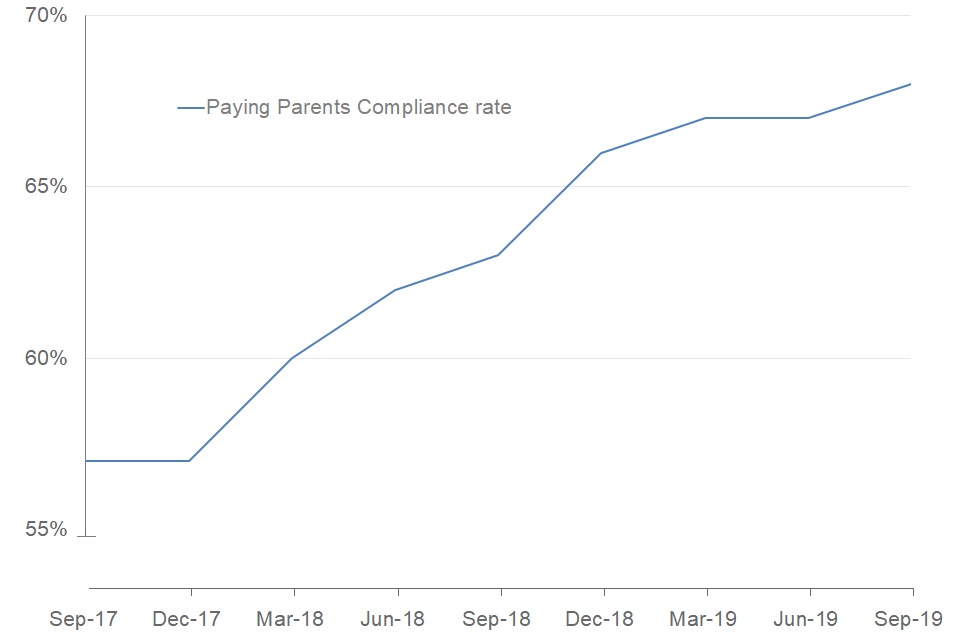
Source: Child Maintenance Service statistics data to September 2019, national tables, table 9.
68% of parents due to pay child maintenance through the Collect and Pay service paid some maintenance in the quarter ending September 2019, up from 63% one year earlier.
This includes parents who transferred from the Direct Pay service, having failed to pay their liabilities.
3. What you need to know
Child maintenance is financial support between separated parents to help with the everyday costs of looking after children.
If they agree, separated parents can arrange child maintenance themselves. This is called a ‘family-based arrangement’ and is a private way to sort out child maintenance. Parents arrange everything themselves and no-one else has to be involved.
The Child Maintenance Service which replaced the Child Support Agency (CSA) is for when parents cannot agree to a family-based arrangement. Parents wishing to use the Child Maintenance Service must first contact Child Maintenance Options (Options).
Child Maintenance Options is a free service that provides impartial information and support to help separated parents make decisions about their child maintenance arrangements.
Figure 3: Outcomes of calls made to Options between November 2018 and January 2019

Source: Child maintenance arrangements made after speaking to CM Options August 2019, table 1.1.
Read information on child maintenance arrangements made after speaking to CM Options.
Definitions
Receiving parent
The receiving parent has the main day-to-day care of the children and receives the child maintenance.
Paying parent
The paying parent does not have the main day-to-day care of the children and pays child maintenance.
Children covered
Children covered is the number of children for whom the paying parent has a child maintenance arrangement.
Compliance
Compliance is where parents using the Collect and Pay service have paid some child maintenance in the last three months.
See the Background Information document for more details.
4. Applications to the Child Maintenance Service
Parents who want to apply to the Child Maintenance Service must pay a £20 application fee. Parents do not have to pay this if they:
- have been a victim of domestic abuse
- have witnessed the abuse of their child by a current or previous partner, or a member of their own or the partner’s family
- are under 19 years of age
Applications to the Child Maintenance Service are from:
- parents making their first arrangement.
- parents who previously had an arrangement with the Child Support Agency
All Child Support Agency cases with an ongoing liability were closed by December 2018, and parents were encouraged to make a new family-based arrangement or an arrangement through the Child Maintenance Service. However, the Child Maintenance Service may still receive applications from such parents, as they may have had a family-based arrangement in the interim.
Figure 4: Arrangements joining the Child Maintenance Service, quarters ending December 2015 to September 2019
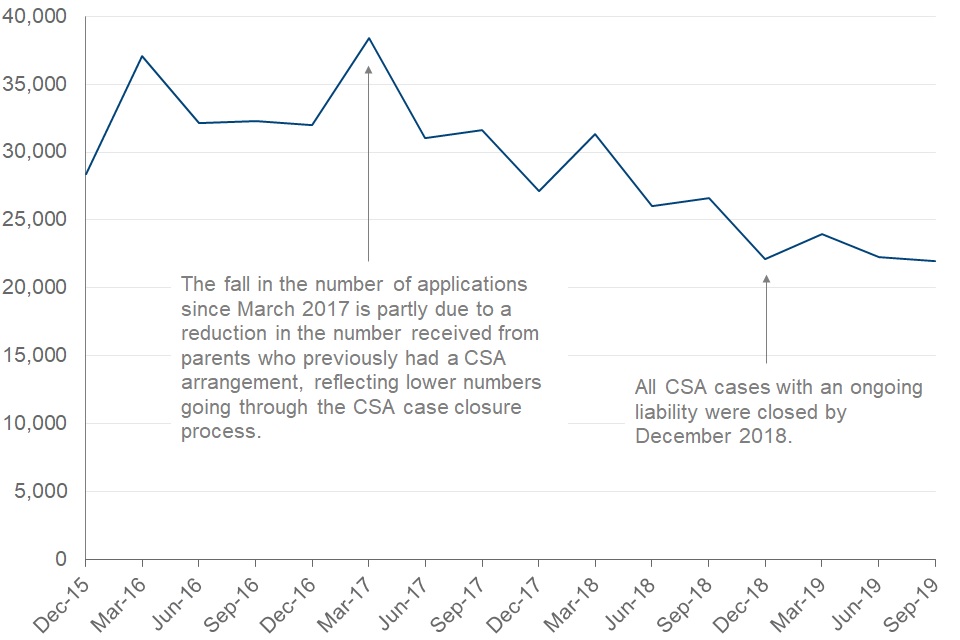
Source: Child Maintenance Service statistics data to September 2019, national tables, table 3.
In the quarter ending September 2019, 22,000 new arrangements joined the Child Maintenance Service.
At the end of September 2019, the Child Maintenance Service was managing 501,000 arrangements for 470,600 paying parents. This is a 11% increase to the number of arrangements since the end of September 2018.
See tables 1 to 4 of the national tables for more information.
5. Composition of cases on the Child Maintenance Service
When a parent makes an application to the Child Maintenance Service, they will be told how much child maintenance should be paid.
Some parents will then arrange the payments between themselves: this service is known as Direct Pay. Parents are issued a text message 3 months after they set up a Direct Pay arrangement, and at each annual review, to check that the arrangement is still meeting their requirements.
If parents cannot arrange payments between themselves, or if the paying parent does not keep up with the payments, the receiving parent can ask the Child Maintenance Service to switch the case to the Collect and Pay service.
This service collects and manages payments between the parents, including recovery of unpaid maintenance that built up under the Direct Pay service.
This could involve the use of enforcement powers. To use the Collect and Pay service, paying parents are charged 20% of their child maintenance, and receiving parents 4%. This is intended to encourage parents to collaborate.
Figure 5: Flow of arrangements on the Child Maintenance Service during the quarter ending September 2019
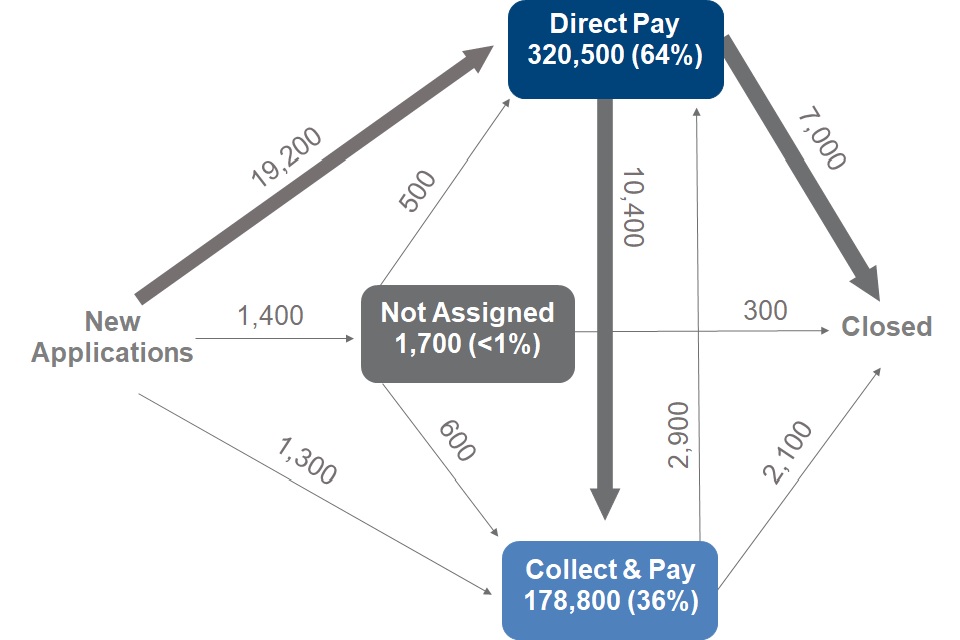
Source: Child Maintenance Service statistics data to September 2019, national tables, table 5.
Each box on Figure 5 shows the number, and percentage, of arrangements using that service type at the end of the quarter. Percentages may not sum to 100% due to rounding. Arrows represent the number of cases that moved between service types during the quarter. The largest flows (over 5,000 cases) are in bold. Some smaller flows are excluded from this diagram, but can be found in table 5 of the national tables.
Figure 5 shows:
- most new applicants choose to start on Direct Pay: 19,200 new applicants joined Direct Pay during the quarter ending September 2019
- 64% of all Child Maintenance Service arrangements use Direct Pay, with 36% using Collect and Pay
- more parents move from Direct Pay to Collect and Pay than the other way around: 10,400 parents switched to Collect and Pay during this quarter
- more arrangements joined the service than left: the number of arrangements increased by 12,900 during this quarter
Paying parents switching onto the Collect and Pay service may owe unpaid maintenance which accumulated under Direct Pay.
Arrangements may not be assigned to a service type for a short period following application.
See tables 4 and 5 of the national tables for more information.
6. Children covered by the Child Maintenance Service
Figure 6: Children covered by Child Maintenance Service arrangements, September 2017 to September 2019
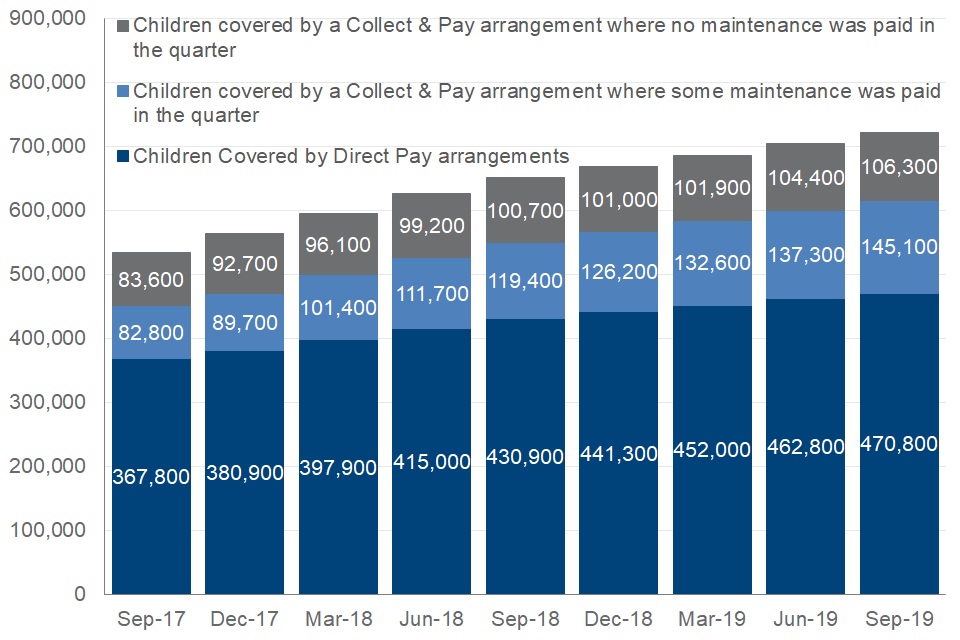
Source: Child Maintenance Service statistics data to September 2019, national tables, table 6.
For presentational reasons, a small number of children, who are covered by arrangements not assigned to a service type, have been excluded from this chart. The chart includes at least 98% of children covered by the Child Maintenance Service for all calendar quarters shown.
At the end of September 2019:
- 470,800 children were covered by 320,500 Direct Pay arrangements
- 251,400 children were covered by 178,800 arrangements through the Collect and Pay service
- 145,100 of these children were covered by 101,500 Collect and Pay arrangements where the paying parent paid some maintenance during the quarter
65% of all children covered by Child Maintenance Service are covered through Direct Pay arrangements, with 20% covered by Collect and Pay arrangements for which some maintenance was paid in the quarter. These proportions have changed little over the last 12 months (compare 66% and 18% in September 2018).
However, the total number of children covered by Direct Pay or paying Collect and Pay arrangements continues to increase each quarter, following the increasing number of cases managed by the Child Maintenance Service. 69,300 more children are covered by a Child Maintenance Service arrangement compared to September 2018.
See table 6 of the national tables for more information.
7. Paying parents and the Collect and Pay service
This includes paying parents transferred from the Direct Pay service because they have failed to keep up with payments.
Figure 7: Compliance rate of paying parents due to pay maintenance through the Collect and Pay service, quarters ending September 2017 to September 2019

Source: Child Maintenance Service statistics data to September 2019, national tables, table 9.
In the quarter ending September 2019, 97,000 paying parents cleared some of their child maintenance through the Collect and Pay service resulting in 145,100 children benefiting from this money.
Compliance has risen from 63% to 68% between the quarter ending September 2018 and the quarter ending September 2019.
See tables 6 and 9 of the national tables for more information.
8. Child Maintenance due and paid
The Child Maintenance Service monitors payments made through the Collect and Pay service and can take enforcement action where necessary.
Parents on Direct Pay with unpaid maintenance owed will first have to transfer to Collect and Pay before the Child Maintenance Service can take any action. This means the Collect and Pay service consists of a subset of paying parents who are less likely to pay.
Figure 8: Child Maintenance due and paid each quarter, quarters ending September 2017 to September 2019
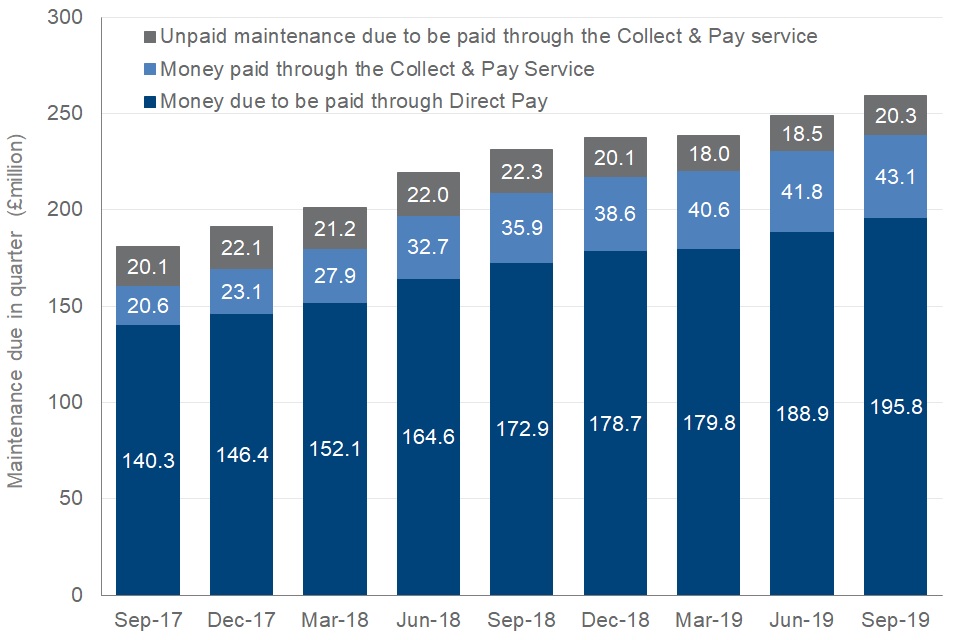
Source: Child Maintenance Service statistics data to September 2019, national tables, table 10.
As a result of problems with data feeds, the figures in this chart for the quarter ending December 2018 are estimates. More detail about this is available in the background Information document.
During the quarter ending September 2019, £259.2 million Child Maintenance was due to be paid.
£238.9 million was paid through the Collect and Pay service or due to be paid through Direct Pay arrangements:
- £195.8 million due to be paid through Direct Pay arrangements
- £43.1 million paid through the Collect and Pay service
The amount of money due to be paid through the Child Maintenance Service has been rising as the number of parents using the service has increased.
£20.3 million of maintenance due to be paid through the Collect and Pay service in the quarter ending September 2019 was not paid. This has fallen from £22.3 million during the same period in 2018, despite the increase in the total amount of maintenance due.
Since 2012, when the Child Maintenance Service began, £315.3 million in unpaid maintenance is owed through the Collect and Pay service. This amounts to 10% of all maintenance due to be paid since the start of the service and includes unpaid maintenance transferred from Direct Pay to Collect and Pay.
See tables 10 and 11 of the national tables for more information.
9. Enforcement
When a payment is missed, the Child Maintenance Service contacts the paying parent to arrange a recovery of what is owed or to make clear the actions that may be pursued in the absence of a payment.
For parents on Collect and Pay, enforcement is automatically pursued on their behalf.
For parents on Direct Pay (where the receiving parent asks the Child Maintenance Service to take action) the arrangement is first switched to the Collect and Pay service before any enforcement action can commence.
The Child Maintenance Service can collect unpaid child maintenance in 3 major ways:
-
deduction from earnings order or request – money is recovered from the paying parent’s earnings via their employer, who will be instructed on the amount to deduct
-
deduction order – money is deducted directly from the paying parent’s bank or building society account
-
courts – a paying parent can be taken to court over unpaid maintenance
The courts can grant liability orders, which allow further action to be taken, such as referral to enforcement agents, who can seize goods and sell them to cover any unpaid maintenance and costs.
Where the paying parent is a homeowner, courts may grant a charging order against the property, which prevents any sale without repayment of the outstanding amount.
Ultimately, the court may grant an order for sale which forces the sale of the property. If these methods are unsuccessful, the Child Maintenance Service may apply for the courts to:
-
disqualify the parent from holding or obtaining a driving license
-
disqualify the parent from holding or obtaining a passport
-
send the parent to prison
Figure 9: Enforcement actions taking place, quarters ending June 2015 to September 2019
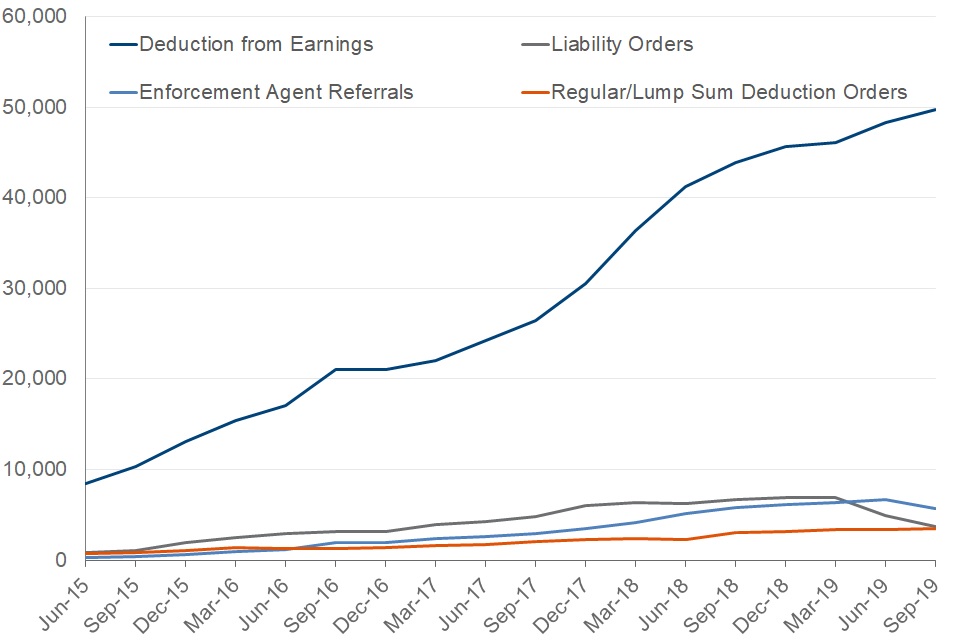
Source: Child Maintenance Service statistics data to September 2019, national tables, table 12.
At the end of September 2019:
-
49,700 deductions from earnings orders and requests were in place
-
3,700 liability orders were in process
-
5,700 enforcement agent referrals were in process
-
3,500 regular and lump sum deduction orders were in process
Intake into the liability order process has remained low this quarter, compared to the beginning of the year. This may be partly due to the extended timeframe required to apply a liability order to arrears that have been transitioned to the Child Maintenance Service from the Child Support Agency: from the quarter ending June 2019, the Child Maintenance Service will confirm the receiving parent wants such debt to be collected before applying for a liability order.
See table 12 of the national tables for more information.
10. About these statistics
Comparisons
Comparisons between these statistics on the Child Maintenance Service and statistics on the Child Support Agency should not be made as the 2 services have different aims and cover different groups.
The government’s changes to the child maintenance system in 2012 were designed to encourage parents to work together to provide for their children. Child Maintenance Options was created to support parents to set up collaborative, family-based arrangement. The Child Maintenance Service was intended for those parents who cannot make family-based arrangements.
Rounding
Figures contained within this publication are rounded to the nearest hundred, percent, or £100,000. Percentages are calculated prior to rounding.
These statistics have been developed using guidelines set out by the UK Statistics Authority.
Changes made to this publication
This release document is now published in a webpage (HTML) format, rather than as a PDF. There are number of benefits to this: the new format is intended to be more accessible, and easier to read on portable devices.
Previously reported counts of paying parents, children, and arrangements (in tables 4, 5, 6, and 8) have undergone small revisions. This is because one of our data sources did not previously contain full information relating to the specific subset of cases where child maintenance arrangements were applied for and created under the Northern Ireland Child Maintenance Service but have subsequently moved to the service in Great Britain. This has now been corrected.
Table 1 (Applications to the Child Maintenance Service) now only reports on the status of applications made in the last 12 months. This is because the source information is not updated beyond this timeframe.
The order of tables and the numbering scheme has changed so that tables relating to the same theme are now grouped together. This is to improve usability and to make the statistics more accessible to users.
Planned changes
In a future publication, we intend to include further information on sanctions applied by the Child Maintenance Service. This will include the number of prison sentences, driving licence confiscations, and passport confiscations ordered by courts (including suspended sentences).
We are working on making Child Maintenance Service data available to access interactively via the Department for Work and Pensions interactive StatXplore tool.
Where to find out more
Read previous releases of these statistics.
Read information and statistics on family-based arrangements.
Authors: James Kerr and Amy Grant
Lead statistician: Juwaria Rahman
Feedback is welcome, send comments to: cm.analysis.research@dwp.gov.uk
